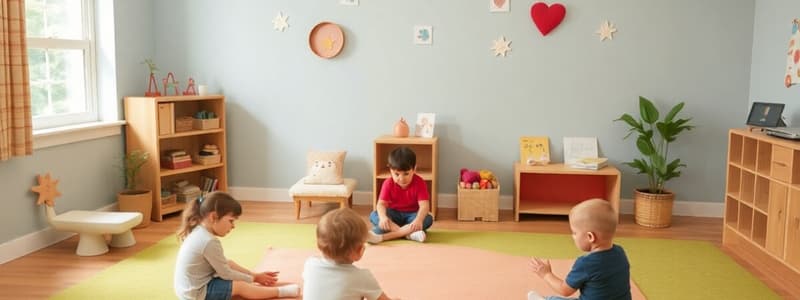Podcast
Questions and Answers
What is a crucial first step in managing a child's emotions effectively?
What is a crucial first step in managing a child's emotions effectively?
- Teaching children to recognize early signs of distress (correct)
- Ignoring children's emotional signals
- Establishing rewards for good behavior
- Creating a strict environment
Which of the following activities can be incorporated into a calming area?
Which of the following activities can be incorporated into a calming area?
- Timed competitions
- Physical games
- Argumentative discussions
- Guided breathing exercises (correct)
How can caregivers model emotional management for children?
How can caregivers model emotional management for children?
- By demonstrating calming strategies (correct)
- By ignoring their own stress
- By avoiding difficult situations
- By showing anger when frustrated
What is the purpose of encouraging children to visit the calming area during calm moments?
What is the purpose of encouraging children to visit the calming area during calm moments?
What outcome does teaching children to self-regulate their emotions generally aim for?
What outcome does teaching children to self-regulate their emotions generally aim for?
Which statement best describes the overall goal of creating a supportive environment for children?
Which statement best describes the overall goal of creating a supportive environment for children?
What impact does integrating positive experiences in the calming area have on children?
What impact does integrating positive experiences in the calming area have on children?
What should educators and caregivers observe to help children manage their emotions?
What should educators and caregivers observe to help children manage their emotions?
What is the primary purpose of calming areas in early childhood educational settings?
What is the primary purpose of calming areas in early childhood educational settings?
How do calming areas contribute to children's self-awareness?
How do calming areas contribute to children's self-awareness?
What skills do calming areas help children develop in the context of conflict resolution?
What skills do calming areas help children develop in the context of conflict resolution?
Why are calming areas particularly beneficial for children with sensory processing needs?
Why are calming areas particularly beneficial for children with sensory processing needs?
How do calming areas empower children's decision-making skills?
How do calming areas empower children's decision-making skills?
What does the reflective process facilitated by calming areas contribute to?
What does the reflective process facilitated by calming areas contribute to?
What role do calming areas play in the emotional intelligence development of children?
What role do calming areas play in the emotional intelligence development of children?
How can educators assist children who are struggling with their emotions in calming areas?
How can educators assist children who are struggling with their emotions in calming areas?
What is a key component of social emotional learning reinforced by calming areas?
What is a key component of social emotional learning reinforced by calming areas?
What is a common misconception about the use of calming areas in early childhood classrooms?
What is a common misconception about the use of calming areas in early childhood classrooms?
Which statement best illustrates the importance of calming areas in emotional processing?
Which statement best illustrates the importance of calming areas in emotional processing?
How does the use of visuals in calming areas assist children?
How does the use of visuals in calming areas assist children?
What is a significant outcome of children learning to use calming areas effectively?
What is a significant outcome of children learning to use calming areas effectively?
Which strategy is important for maximizing the effectiveness of calming areas?
Which strategy is important for maximizing the effectiveness of calming areas?
Study Notes
Calming Areas in Early Childhood Education
- Purpose: Calming areas, also known as quiet corners or peaceful places, are designated spaces in early childhood settings that provide a sanctuary for young children to relax and regulate their emotions.
- Benefits:
- Emotional Regulation: They offer a safe and serene environment for children to retreat when feeling overwhelmed, upset, or frustrated. This helps them learn to manage and process their emotions healthily.
- Self-Reflection and Awareness: Children can pause, reflect on their feelings and actions, and gain a deeper understanding of their emotional responses.
- Conflict Resolution: They provide a neutral zone where children can cool down and collect their thoughts before engaging in problem-solving and resolving conflicts with peers. They learn negotiation and empathy skills.
- Sensory Processing: For children sensitive to noise, light, or other stimuli, these areas offer a retreat to alleviate sensory overload, allowing them to decompress and regain balance.
- Independence and Decision-Making: Children are empowered to choose when to use these spaces, recognizing and addressing their needs. This fosters a sense of responsibility and self-efficacy.
Implementing Calming Areas
- Proactive Strategies: Encourage children to use calming areas before their emotions become dysregulated, preventing meltdowns or tantrums.
- Early Signs of Distress: Educators and caregivers should be observant of children's early signs of distress, such as changes in body language, facial expressions, or behavior.
- Language and Tools: Teaching children to identify their emotional triggers and understand their own signs of stress helps them self-regulate more effectively.
- Normalizing Use: Encourage children to visit the calming area during calm moments, making its use a normal part of their routines. This fosters comfort and confidence.
- Positive Experiences: Incorporate calming activities like guided breathing exercises, storytelling, or quiet play to create a positive association with the calming space.
- Modeling Strategies: Educators and caregivers should model calming strategies, demonstrating that taking a moment to regroup is a valuable and normal part of emotion management.
Overall Impact
- Calming areas create a supportive and nurturing environment where children feel safe and understood.
- They empower children to recognize their needs and take proactive steps to address them, reducing emotional outbursts.
- They contribute to children's overall well-being and development, equipping them with essential skills for lifelong success.
Studying That Suits You
Use AI to generate personalized quizzes and flashcards to suit your learning preferences.
Description
Explore the significance of calming areas in early childhood education. This quiz will address the benefits these spaces provide, including emotional regulation, self-reflection, and conflict resolution skills for young children. Discover how these environments contribute to healthy emotional development.




